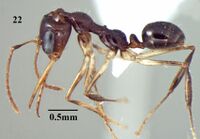Myrmoteras moffetti
| Myrmoteras moffetti | |
|---|---|

| |
| Scientific classification | |
| Kingdom: | Animalia |
| Phylum: | Arthropoda |
| Class: | Insecta |
| Order: | Hymenoptera |
| Family: | Formicidae |
| Subfamily: | Formicinae |
| Tribe: | Myrmoteratini |
| Genus: | Myrmoteras |
| Species: | M. moffetti |
| Binomial name | |
| Myrmoteras moffetti Bharti & Akbar, 2014 | |
Nothing is known about the biology of Myrmoteras moffetti.
Identification
Bharti and Akbar (2014) - M. moffetti is similar to Myrmoteras bakeri in most of the characters but, differs from the later species mainly by following characters: body dark brown; mandibles with 14 teeth with two apical denticles, pronotum smooth and shiny without longitudinal rugae, dorsum of mesothorax granulo-rugose and relatively slender tibiae (TWI <21) whilst in M. bakeri, body light brown; mandibles with11-12 teeth with two apical denticles, pronotum with longitudinal rugae, dorsum of mesothorax loosely granulated and relatively dilated tibiae (TWI>23). The new species also shares some affinities with another Indian species Myrmoteras indicum. However, the two species are easily separated by combination of characters provided in the key.
Keys including this Species
Distribution
Distribution based on Regional Taxon Lists
Oriental Region: India (type locality).
Distribution based on AntMaps
Distribution based on AntWeb specimens
Check data from AntWeb
Countries Occupied
| Number of countries occupied by this species based on AntWiki Regional Taxon Lists. In general, fewer countries occupied indicates a narrower range, while more countries indicates a more widespread species. |

|
Estimated Abundance
| Relative abundance based on number of AntMaps records per species (this species within the purple bar). Fewer records (to the left) indicates a less abundant/encountered species while more records (to the right) indicates more abundant/encountered species. |

|
Biology
Castes
Nomenclature
The following information is derived from Barry Bolton's Online Catalogue of the Ants of the World.
- moffetti. Myrmoteras moffetti Bharti & Akbar, 2014: 74, figs. 22-24 (w.) INDIA.
Unless otherwise noted the text for the remainder of this section is reported from the publication that includes the original description.
Description
Worker
(Holotype in brackets). TL 4.90-5,03(5.03), HW 1.01-1.04(1.03), HL 0.92-0.94(0.94), CI 109-110(109), ML 1.50-1.52(1.52), MI 161-163(161), SL 1.03-1.05(1.04), SI 100-101(100), PTL 0.16-0.18(0.18), EL 0.27-0.29(0.29), HFL 1.10-1.13(1.13), TWI 18-19(19), WL 1.32-1.35 (1.35), EI 26-28(28), GL 1.00-1.04(1.04), PW 0.65-0.67(0.68) (n=3).
Head 0.09× as broad as long; blunt ridge on temple separates flat anterior from slightly convex posterior face; medial frontal sulcus deeply impressed posteriorly reaching anterior ocellus and anteriorly up to margin of frons; clypeus with anterior margin concave and posteriomedially prominently elevated; mandibles long with 14 teeth consisting of 5 large and 9 small teeth (mandibular teeth count include the preapical and apical denticles); maxillary palp with 5- and labial palp 3-segmented. Antennal scrobes indistinct; antennae with slender funiculus, each segment about 2× as long as broad.
Mesosoma. Pronotum with summit gently convex, slightly higher than mesonotum; metanotum groove conspicuously impressed; propodeum feebly convex and with summit virtually level with mesothorax. Legs with middle and hind tibiae slender.
Metasoma. Petiole node moderately thick with anterior face straight and posterior face less steep and curving gently into summit; summit rounded and moderately wide. Gaster small and rounded.
Sculpture. Mandibles smooth. Head and occiput smooth and shiny, with the exception of three to four rugae originating posteriomedially of torulus. Frons, temples and vertex smooth and shiny. Pronotum smooth and shiny; mesonotum, metanotum and propodeum strongly granulo-rugose; gaster smooth and shiny.
Vestiture. Body pilosity reduced; moderate, short suberect hairs distributed evenly throughout the body. Head with the longest hair, ca. 0.15mm. Apical funicular segments, mandibles and legs with small standing hairs.
Colour. Body uniformly dark brown. Mandibles and antennae yellow with tint of brown; palpi yellow. Legs largely yellow with trochanter brown.
Type Material
Holotype and 2 paratypes (worker): India: KERALA: Periyar tiger reserve, Thanikkudy, 9°30`N, 77°16`E, 1003m a.m.s.l., 15.X.2011, hand picking method, Coll. Shahid A. Akbar. Holotype and paratype in Punjabi University Ant Collection, one paratype will be deposited in The Natural History Museum.
Etymology
The species is named in honor of Mark Moffett, for his contributions to the genus Myrmoteras.
References
References based on Global Ant Biodiversity Informatics
- Dad J. M., S. A. Akbar, H. Bharti, and A. A. Wachkoo. 2019. Community structure and ant species diversity across select sites ofWestern Ghats, India. Acta Ecologica Sinica 39: 219–228.

